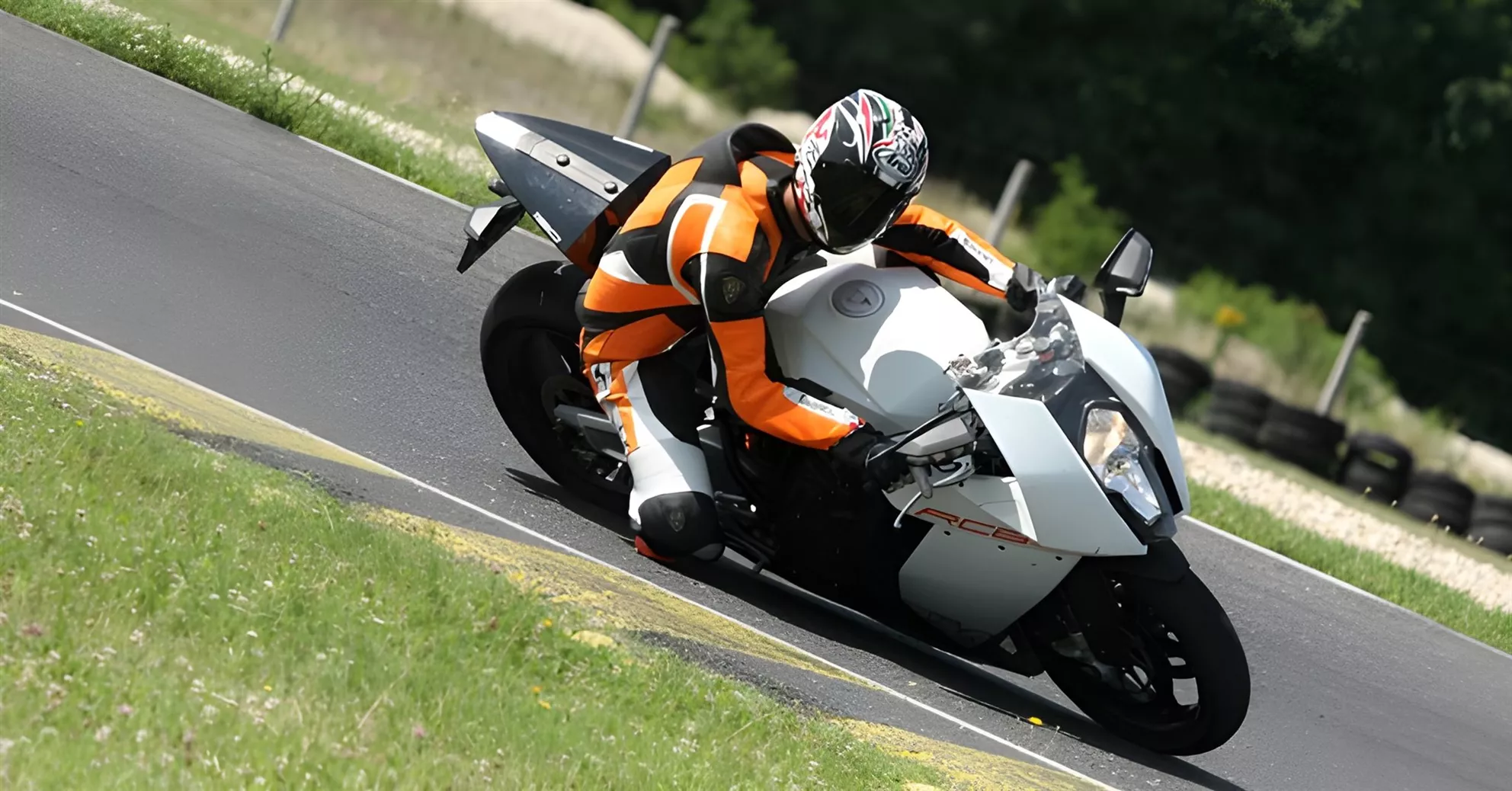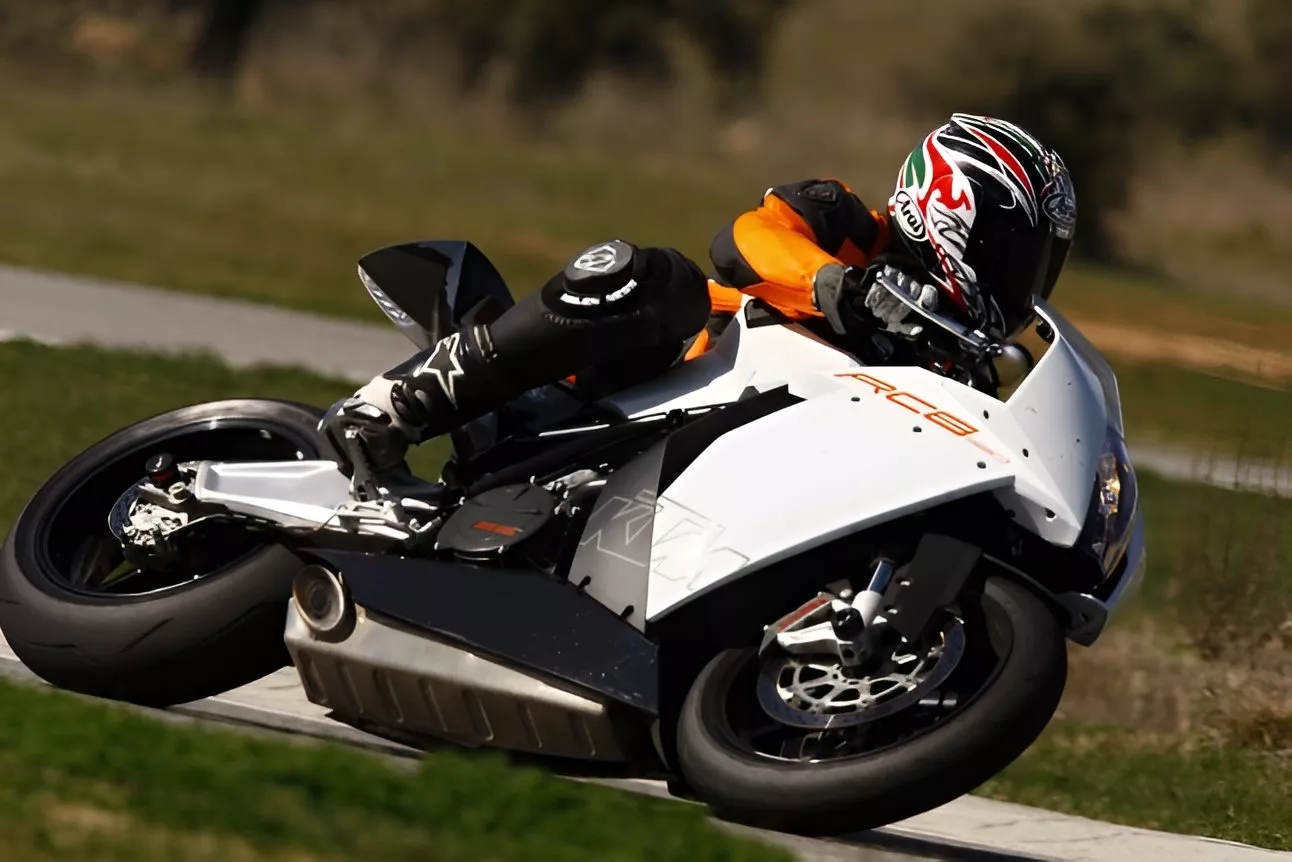It was 2008 when KTM introduced its first full-fledged superbike, taking the final step to becoming a full-range manufacturer. I vividly remember the day I first got to test the RC8 in the Andalusian mountains. Unlike most superbike presentations, KTM had the courage to let us not only on the track but also on the twisty roads around Ronda. A bold move that turned out to be a spot-on decision, revealing the true strength of the RC8: it was a superbike that you could genuinely enjoy on the street. What surprised me back then was the discrepancy between the aggressive, angular design and the bike's actual character. The RC8's appearance screamed "Ready to Race," yet its handling was surprisingly balanced and approachable. With 155 horsepower from the V2 engine, it promised plenty of power but delivered it in an unusually civilized manner. This was in stark contrast to the Superduke R, whose 120 horsepower felt significantly wilder. The RC8 followed a different philosophy—it wasn't a no-compromise hooligan but a precise tool that allowed even non-racers access to high performance. What particularly impressed me was the bike's adaptability. The seat height, handlebar position, and footpeg setup could all be adjusted to suit the rider. The mechanics set up the bike for us in the morning for the street and in the afternoon for the track. This versatility was a unique selling point in the superbike segment, where many competitors were designed for the mythical "average rider" of 75 kg and 1.70 m height. "Even KTM engineers appreciate a hearty meal," as I wrote back then—and you could definitely see that in the bike's ergonomics.

KTM 1190 RC8 Review and Retrospective
When KTM Entered the World of Superbikes
A look back at a fascinating superbike. In 2008, KTM unveiled the new KTM 1190 RC8. How do we view it now?
&width=72&height=72&bgcolor=rgba_39_42_44_0&mode=crop)
nastynils
published on 08/06/2025
From the Test Track to Enthusiasts' Garages
Today, more than 15 years after my first encounter with the RC8, the status of this motorcycle has fundamentally changed. What was considered the first attempt by an off-road specialist in the superbike segment has evolved into a coveted collector's item. Countless conversations with RC8 owners over the years paint a clear picture: the KTM RC8 has become a rarity appreciated by connoisseurs.
When the RC8 hit the market in 2008, it was met with skepticism. An Austrian manufacturer daring to compete with the Japanese and Italian giants? That seemed bold. Today, community experience shows that this very uniqueness is what gives it its special appeal. In an era when electronic aids were not yet ubiquitous, the RC8 offered an authentic, analog riding experience that is more appreciated now than ever.
The intuitive throttle response and linear power band of the V2 engine are regularly cited in forums as the main reasons why owners don't part with their RC8s even years later. What I once described as "unspectacular" has proven to be a sustainable virtue. The precision with which you can control the rear wheel makes the RC8, according to community feedback, an excellent choice for track days—especially for riders who don't hit the racetrack every weekend.

NastyNils on the KTM RC8 Saddle in 2008
From the Test Track to the Enthusiasts' Garage
Today, more than 15 years after my first encounter with the RC8, the status of this motorcycle has fundamentally transformed. What was once seen as an off-road specialist's initial foray into the superbike segment has evolved into a sought-after collector's item. Numerous conversations with RC8 owners over the years paint a clear picture: the KTM RC8 has become a rarity appreciated by aficionados.
When the RC8 hit the market in 2008, it was met with skepticism. An Austrian manufacturer daring to challenge the Japanese and Italian giants? That seemed bold. Today, community feedback reveals that this very distinctiveness is what gives it its unique charm. In an era when electronic aids were not yet widespread, the RC8 offered an authentic, analog riding experience that is more valued now than ever.
The intuitive throttle response and the linear power band of the V2 engine are frequently cited in forums as the primary reasons why owners remain loyal to their RC8s even after years. What I once described as "unspectacular" has proven to be a lasting virtue. The precision with which you can control the rear wheel makes the RC8, according to community feedback, an excellent choice for track days—especially for riders who don't hit the racetrack every weekend.

NastNils with the RC8 at the 2008 International Press Test
From Outsider to Cult Icon
"They don't make 'em like they used to" – this saying perfectly fits the RC8. As the last major superbike without electronic aids like traction control or cornering ABS, it represents the end of an era. The collector and enthusiast scene has grown significantly in recent years, which is also reflected in its price development. While the RC8 was originally available for just under 18,000 euros, well-maintained examples today hold their value remarkably well—some rare versions even fetch prices above the original new price. The community particularly values the RC8's exceptional build quality. The steel tubular frame, which impressed back then at just over 7 kg, has proven to be extremely durable. The welds are considered a benchmark for precision and durability. The use of high-quality components like WP suspension elements and Brembo brakes pays off in the long run—a point I highlighted as an advantage in the original test. What particularly surprises me: the initial criticism of the squeaky rear brake and the gearbox, which was sometimes perceived as notchy, has largely been downplayed by the rider community. With proper break-in and maintenance, these issues usually disappear. The bike's adaptability, which I once saw as a potential risk for the "least savvy user" (DAU), has proven to be one of its greatest long-term advantages. Owners report that they have been able to adjust their RC8 to their evolving needs over the years—a luxury that hardly any other production motorcycle offers.
Technical Durability and Common Weaknesses
The RC8's V2 engine has proven to be exceptionally robust. The community reports of models that have easily surpassed the 100,000-kilometer mark—a remarkable achievement for a superbike. Particularly noteworthy is the durability of the valve train: while regular valve clearance checks are standard for other high-performance motorcycles, RC8 riders report surprisingly consistent values over long periods. However, there are some weaknesses known within the community. The cooling system is among the more critical points. In hot regions or during intense track use, overheating can occur. The solution is usually an upgraded radiator or an oil cooler upgrade, which many owners carry out as a preventive measure. The alternator has been found to be vulnerable in some models, especially those frequently used in city traffic. The stock regulator/rectifier often operates at its limit, prompting many owners to opt for reinforced aftermarket solutions. Another point regularly discussed in rider forums is the primary drive. The clutch works reliably with gentle riding but can wear out with intense track use or frequent wheelies. Reinforced clutch springs have become an economical preventive measure here. The maintenance intervals, at 7,500 km for minor and 15,000 km for major services, are relatively generous. Most maintenance can be performed by skilled DIY mechanics—a benefit of the straightforward layout without excessive electronics. Parts availability has been surprisingly good so far, thanks to KTM's ongoing commitment to this model. Even for the first version, all essential wear and service parts were still available until 2024. Additionally, an active used parts market has developed, coordinated through international RC8 forums.
The RC8 in Today's Used Market: A Rare Find with Stable Value
The search for a used RC8 is becoming increasingly difficult—a clear sign of the cult status this motorcycle has achieved. On our 1000PS market, rarely more than a handful of examples are available at any given time. Prices currently start at around 8,000 euros for early models with higher mileage and go up to 15,000 euros for well-maintained later RC8 R models.
Especially sought after are the limited editions like the RC8 R Track or the RC8 R Red Bull Edition, for which collectors pay over 20,000 euros. These models often represent an investment, as their rarity and now high recognition in the scene ensure stable or even rising prices. An interesting phenomenon discussed in forums: the original orange color variant is now fetching higher prices than the version that was once considered "more elegant" in white.
In purchase advice, owners agree: condition is more important than mileage. A well-maintained example with 40,000 km is preferable to a neglected RC8 with 15,000 km. Special attention should be paid to the service history—regular oil changes and adhered inspection intervals are crucial for the engine's longevity.
Another important point: adjustments to ergonomics and suspension. Since the RC8 is so versatile in its adjustability, it is worth looking for an example that has already been configured to match your body type and riding style. A complete re-adjustment requires time, patience, and ideally experience. The community also recommends looking for examples that haven't been overly modified—original or RC8s equipped with high-quality components sell for higher prices and are easier to sell later.
Looking back on the KTM 1190 RC8 today, more than a decade and a half after my first test, my initial impression is reinforced: this was a special motorcycle that was ahead of its time in many ways. What was once described as "different than expected" has proven to be forward-thinking. Its adaptability to different rider types and uses, high build quality, and intuitive power delivery are virtues that are more valued than ever in times of excessive electronics and limited repairability. The RC8 represents the end of an era today—it is the last great superbike that managed without electronic aids and was still accessible to a wide range of riders. It embodies a philosophy that favored riding skills over electronic correction, without being so uncompromising that only pros could master it. This balance makes it even more remarkable in retrospect.
Who is the RC8 still right for today? Definitely for lovers of analog riding experiences who are looking for a superbike that performs as well on the road as it does on the track. For collectors who want to own a piece of motorcycle history that is likely to hold or even increase in value. And not least for riders looking for a distinctive alternative to Japanese and Italian superbikes.
As for me, had I known back then the significance the RC8 would hold today, I probably would have put one in my garage. It's the fate of a motorcycle journalist to ride many exceptional bikes but own only a few in the long term. The RC8 is definitely one of those bikes where I now say: that would have been a wise investment—not just financially, but above all emotionally.
- How much does a KTM 1190 RC8 cost?
- Here you will find an overview of the price level of new and used motorbikes!
&width=60&height=60&bgcolor=rgba_39_42_44_0&mode=crop)
KTM 1190 RC8 2008 - Experiences and Expert Review
nastynils
The KTM RC8 boasts great ergonomics and a high-quality chassis. It's a real blast on the road and truly a charisma bomb.